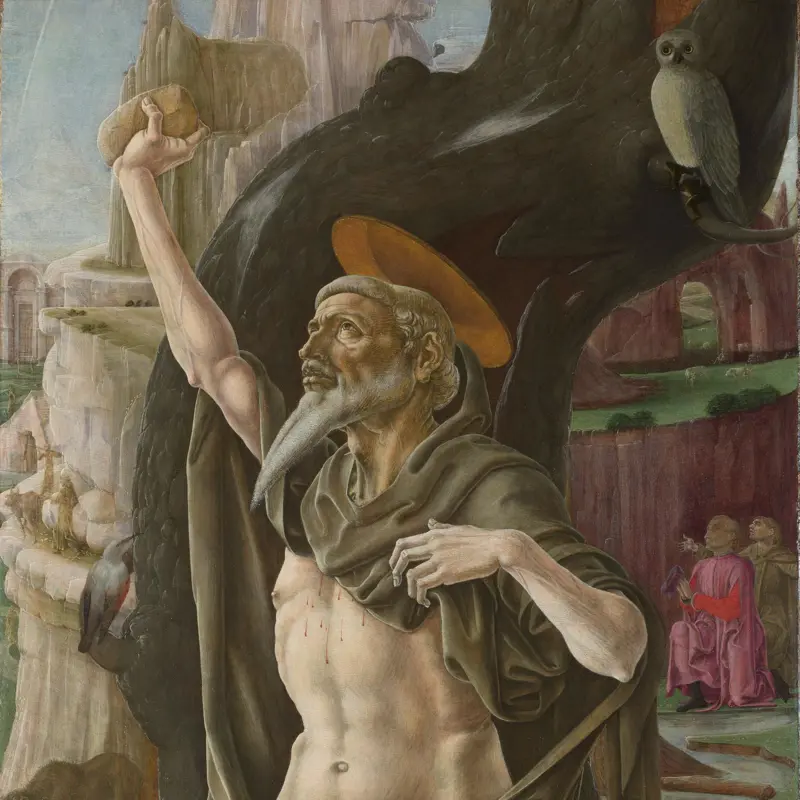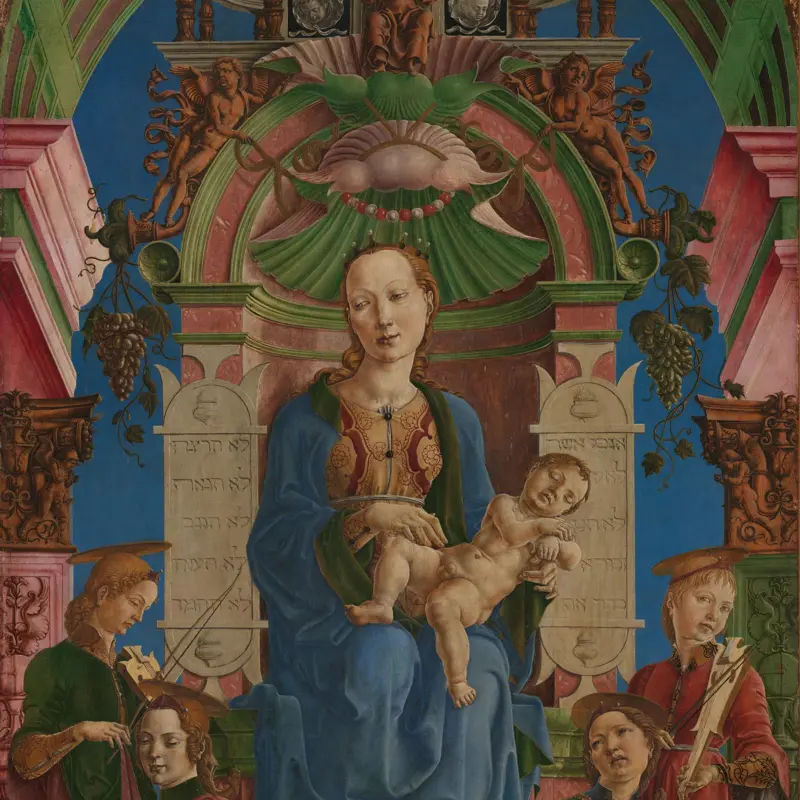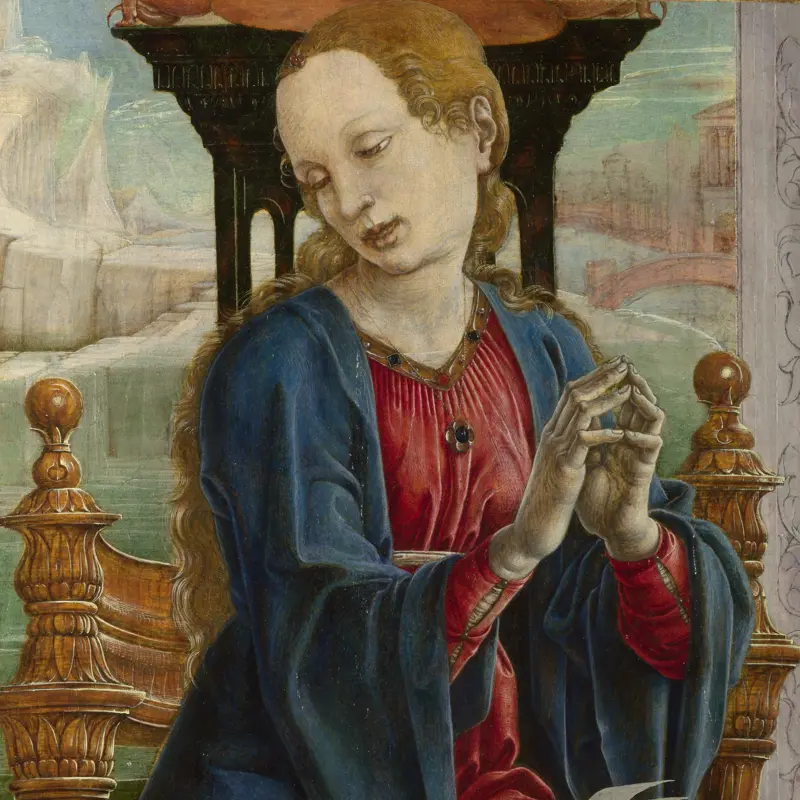Cosimo Tura, 'A Muse (Calliope?)', probably 1455-60
About the work
Overview
This imperious lady once looked down from the walls of the studiolo (study) at Belfiore, the hunting retreat belonging to the dukes of Ferrara, part of a decorative scheme showing the nine Muses. The theme was chosen by Leonello d’Este, Duke of Ferrara, and was begun by a painter called Angelo da Siena. After Leonello’s death in 1450 and Angelo’s in 1456, Leonello’s brother Borso hired Tura to produce the work.
The Muses were mythological figures, the daughters of Jupiter and Mnemosyne (Memory). They embodied divine inspiration for the arts, each representing a specific art form. Our muse has been identified as Calliope, the muse of poetry. The branch of cherries may refer to justice, a principle with which Calliope was sometimes associated.
Technical analysis reveals that Tura painted this image using oil paint over a different design, possibly by Angelo da Siena. The technique is flawless and suggests knowledge of the work of the Netherlandish artist Rogier van der Weyden.
Key facts
Details
- Full title
- A Muse (Calliope?)
- Artist
- Cosimo Tura
- Artist dates
- Before 1431 - 1495
- Date made
- Probably 1455-60
- Medium and support
- Oil over egg tempera on wood (poplar)
- Dimensions
- 116.2 × 71.1 cm
- Acquisition credit
- Layard Bequest, 1916
- Inventory number
- NG3070
- Location
- Room 14
- Collection
- Main Collection
- Commissioners
- Previous owners
- Frame
- 15th-century Italian Frame
Provenance
Additional information
Text extracted from the ‘Provenance’ section of the catalogue entry in Martin Davies, ‘National Gallery Catalogues: The Earlier Italian Schools’, London 1986; for further information, see the full catalogue entry.
Exhibition history
-
2014Making ColourThe National Gallery (London)18 June 2014 - 7 September 2014
Bibliography
-
1773G.A. Scalabrini, Memorie istoriche delle chiese di Ferrara, Ferrara 1773
-
1782C. Cittadella, Catalogo istorico de' pittori e scultori ferraresi, 4 vols, Ferrara 1782
-
1836G. Baruffaldi, Vita di Cosimo Tura, pittore ferrarese del secolo xv, corredata di note, Bologna 1836
-
1838C. Laderchi, Descrizione della quadreria Costabili, 4 parts, Ferrara 1838
-
1844G. Baruffaldi, Vite de' pittori e scultori Ferraresi, ed. G. Boschini, Ferrara 1844
-
1871J.A. Crowe and G.B. Cavalcaselle, A History of Painting in North Italy: Venice, Padua, Vicenza, Verona, Ferrara, Milan, Friuli, Brescia, from the Fourteenth to the Sixteenth Century, 2 vols, London 1871
-
1884F. Harck, 'Die Fresken im Palazzo Schifanoja in Ferrara', Jahrbuch der Königlich Preussischen Kunstsammlungen, V, 1884, pp. 99-127
-
1885A. Venturi, 'L'arte a Ferrara nel periodo di Borso d'Este', Rivista storica italiana, II, 1885, pp. 689-749
-
1888F. Harck, 'Verzeichnis der Werke des Cosma Tura', Jahrbuch der Königlich Preussischen Kunstsammlungen, IX, 1888, pp. 34-40
-
1889A. Venturi, 'L'arte Ferrarese nel periodo d'Ercole I d'Este', in Atti e memorie della R. Deputazione di Storia Patria per le Provincie di Romagna, Bologna 1889, vol. 7, pp. 368-412
-
1892G. Gruyer, 'Cosimo Tura', L'Art, 1892, pp. 1-30
-
1895G. Lafenestre and E. Richtenberger, Venise, Paris 1895
-
1897G. Gruyer, L'art ferrarais à l'époque des princes d'Este, Paris 1897
-
1901A. Venturi, Storia dell'arte italiana, 11 vols, Milan 1901
-
1907B. Berenson, North Italian Painters of the Renaissance, New York 1907
-
1912J.A. Crowe and G.B. Cavalcaselle, A History of Painting in North Italy: Venice, Padua, Vicenza, Verona, Ferrara, Milan, Friuli, Brescia, from the Fourteenth to the Sixteenth Century, ed. T. Borenius, 2nd edn, 3 vols, London 1912
-
1931A. Venturi, North Italian Painting of the Quattrocento: Emilia, Lombardy, Piedmont, Liguria, Florence 1931
-
1932B. Berenson, Italian Pictures of the Renaissance: A List of the Principal Artists and Their Works, with an Index of Places, Oxford 1932
-
1933G. Gombosi, 'A Ferrarese Pupil of Piero della Francesca', The Burlington Magazine, LXII/359, 1933, pp. 66-78
-
1936B. Berenson, Pitture italiane del Rinascimento: Catalogo dei principali artisti e delle loro opere con un indice dei luoghi, Milan 1936
-
1940H. Beenken, 'Angelo del Maccagnino und das Studio von Belfiore', Jahrbuch der Königlich Preussischen Kunstsammlungen, LXI, 1940, pp. 147-62
-
1940O. Härtzsch, 'Cosimo Tura', Pantheon, XXVI, 1940, pp. 153-61
-
1941S. Ortolani, Cosmè Tura, Francesco del Cossa, Ercole de' Roberti, Milan 1941
-
1947H. Friedmann, 'The Symbolism of Crivelli's Madonna and Child Enthroned with Donor in the National Gallery', Gazette des beaux-arts, XXXII, 1947, pp. 65-72
-
1950B. Nicolson, The Painters of Ferrara: Cosmè Tura, Francesco Del Cossa, Ercole de' Roberti and Others, London 1950
-
1951Davies, Martin, National Gallery Catalogues: The Earlier Italian Schools, London 1951
-
1953A. Neppi, Cosmè Tura: Saggio critico, Milan 1953
-
1954C. Padovani, La critica d'arte e la pittura ferrarese, Rovigo 1954
-
1957M. Salmi, Cosmé Tura, Milan 1957
-
1958E. Ruhmer, Tura: Paintings and Drawings, London 1958
-
1961M. Davies, The Earlier Italian Schools, 2nd edn, London 1961
-
1965M. Baxandall, 'Guarino, Pisanello and Manuel Chrysoloras', Journal of the Warburg and Courtauld Institutes, XXVIII, 1965, pp. 183-204
-
1968R. Longhi, Ampliamento nell'Officina ferrarese, Rome 1968
-
1974R. Molajoli, Cosmè Tura e i grandi pittori ferraresi del suo tempo : Francesco Cossa e Ercole de' Roberti, Milan 1974
-
1975A. Eörsi, 'Lo studiolo di Lionello d'Este e il programma di Guarino da Verona', Acta historiae artium, XXI, 1975, pp. 15-52
-
1975W. Zanini, 'Opere che gravitano intorno allo studio di Belfiore', Musei Ferraresi, Bollettino Annuale, V-VI, 1975, pp. 16-23
-
1982S. Macioce, 'La Borsiade di Tito Vespasiano Strozzi e la Sala dei Mesi di Palazzo Schifanoia', Annuario dell'Istituto di storia dell'arte, II, 1982, pp. 3-13
-
1983S. Macioce, 'Palazzo Schifanoia: Una proposta iconologica per il Settembre nella Sala dei Mesi', Storia dell'arte, XLVIII, 1983, pp. 75-99
-
1985C.T. Dowd, 'The Travel Diary of Otto Mündler', The Walpole Society, LI, 1985
-
1986Davies, Martin, National Gallery Catalogues: The Earlier Italian Schools, revised edn, London 1986
-
1987J. Dunkerton, A. Roy and A. Smith, 'The Unmasking of Tura's "Allegorical Figure": A Painting and its Concealed Image', National Gallery Technical Bulletin, XI, 1987, pp. 5-35
-
1989M. Lucco, La pittura nel Veneto: Il Quattrocento, 2 vols, Milan 1989
-
1989R. Varese, Atlante di Schifanoia, Modena 1989
-
1990A. Ugolini, 'Rivedendo la Collezione Costabili di Ferrara', Paragone, XLI/489, 1990, pp. 50‑76
-
1991J. Dunkerton et al., Giotto to Dürer: Early Renaissance Painting in the National Gallery, New Haven 1991
-
1991Mottola Molfino and M. Natale (eds), Le muse e il principe: Arte di corte nel Rinascimento padano (exh. cat. Palazzo Poldo-Pezzoli, 20 September - 1 December 1991), Modena 1991
-
1992R. Bellucci, 'La scuola ferrarese: Indagine e confronti tecnici sulle Muse dello studiolo di Belfiore', OPD restauro, IV, 1992, pp. 189-215
-
1992M. Toffanello, 'I pannelli del polittico di Cosmè Tura: Alcune osservazioni sull'ultima attività dell'artista', Arte documento, VI, 1992, pp. 97-102
-
1993J. Anderson, 'Documents for the History of Collecting: 16: The Rediscovery of Ferrarese Renaissance Painting in the Risorgimento', The Burlington Magazine, CXXXV/1085, 1993, pp. 539-49
-
1994S.J. Campbell, Cosmé Tura: Art and Social Identity in Fifteenth-Century Ferrara, Ann Arbor 1994
-
1995C. de Benedictis, Per la storia del collezionismo italiano, fonti e documenti, Florence 1995
-
1995A. Cole, Virtue and Magnificence: Art of the Italian Renaissance Courts, New York 1995
-
1995T. Lamb and J. Bourriaus (eds), Colour: Art and Science, Cambridge 1995
-
1995S.J. Campbell, 'Sic in Amore Furens": Painting as Poetic Theory in the Early Renaissance', I Tatti Studies, VI, 1995, pp. 145-68
-
1996G. Bandini and S.P. Paci, Da donna a madre: Vesti e ceramiche particolari per momenti speciali, Florence 1996
-
1997S.J. Campbell, Cosmé Tura of Ferrara: Style, Politics and the Renaissance City, 1450-1495, New Haven 1997
-
1997K. Conradi, Malerei am Hofe der Este: Cosmè Tura, Francesco del Cossa, Ercole de' Roberti, Hildesheim 1997
-
1997Y. Kyotani, 'Il trionfo di Vesta come Il trionfo della castità: L'analisi iconografica del "Dicembre" della Sala dei Mesi nel Palazzo Schifanoia', Schifanoia, 1997, pp. 203-14
-
1997M. Toffanello, 'I primi vent'anni di attività di Cosmè Tura alla luce dell'analisi tecnica', Dialoghi di storia dell'arte, 4-5, 1997, pp. 10-23
-
1998E. Mattaliano, La collezione Costabili, ed. G. Agostini, Venice 1998
-
1998C. Gilbert, 'The Two Italian Pupils of Rogier van der Weyden: Angelo Macagnino and Zanetto Bugatto', Arte lombarda, CXXII, 1998, pp. 5-18
-
1999M. Molteni, Cosmé Tura, Milan 1999
-
2000J. Manca, Cosmé Tura: The Life and Art of a Painter in Estense Ferrara, Oxford 2000
-
2000P. Bayser, 'Cosmé Tura: Une étrange Renaissance', Beaux-arts, 193, 2000, pp. 78-85
-
2000S.J. Campbell, 'Mantegna's Parnassus: Reading, Collecting and the Studiolo', in G. Neher and R. Shepherd (eds), Revaluing Renaissance Art, Aldershot 2000, pp. 69-87
-
2001
C. Baker and T. Henry, The National Gallery: Complete Illustrated Catalogue, London 2001
-
2002S.J. Campbell et al., Cosmè Tura: Painting and Design in Renaissance Ferrara (exh. cat. Isabella Stewart Gardner Museum, 30 January - 12 May 2002), Boston 2002
-
2004S.J. Campbell, The Cabinet of Eros: Renaissance Mythological Painting and the Studiolo of Isabella d'Este, New Haven 2004
-
2005A. Antonelli, 'Carlo Crivelli e Cosmé Tura: Una congiuntura iconografica tra Ferrara e le Marche', Notizie da Palazzo Albani, XXXIV-XXXV, 2005, pp. 5-23
-
2006W. Partridge, 'Philosophies and Tastes in Nineteenth-Century Paintings Conservation', in M. Perry et al., Studying and Conserving Paintings: Occasional Papers on the Samuel H. Kress Collection, London 2006, pp. 19-23
-
2008G. Forgione, 'La "follia" ferrarese e la "ragione" di Piero: I due Rinascimenti', Storia dell'arte, XIX, 2008, pp. 53-68
About this record
If you know more about this work or have spotted an error, please contact us. Please note that exhibition histories are listed from 2009 onwards. Bibliographies may not be complete; more comprehensive information is available in the National Gallery Library.



